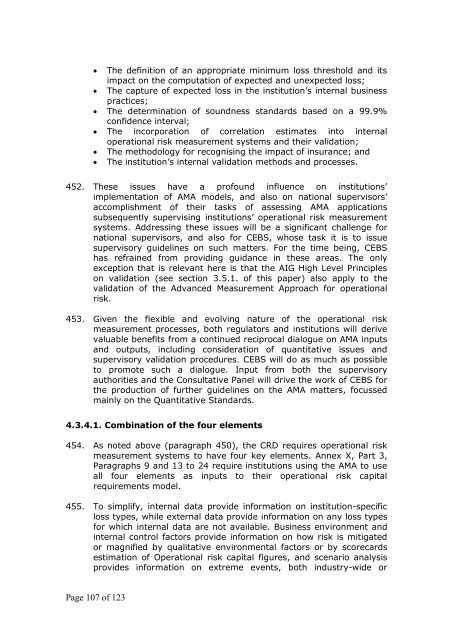CP10 (Full Document) - European Banking Authority
CP10 (Full Document) - European Banking Authority
CP10 (Full Document) - European Banking Authority
Create successful ePaper yourself
Turn your PDF publications into a flip-book with our unique Google optimized e-Paper software.
· The definition of an appropriate minimum loss threshold and its<br />
impact on the computation of expected and unexpected loss;<br />
· The capture of expected loss in the institution’s internal business<br />
practices;<br />
· The determination of soundness standards based on a 99.9%<br />
confidence interval;<br />
· The incorporation of correlation estimates into internal<br />
operational risk measurement systems and their validation;<br />
· The methodology for recognising the impact of insurance; and<br />
· The institution’s internal validation methods and processes.<br />
452. These issues have a profound influence on institutions’<br />
implementation of AMA models, and also on national supervisors’<br />
accomplishment of their tasks of assessing AMA applications<br />
subsequently supervising institutions’ operational risk measurement<br />
systems. Addressing these issues will be a significant challenge for<br />
national supervisors, and also for CEBS, whose task it is to issue<br />
supervisory guidelines on such matters. For the time being, CEBS<br />
has refrained from providing guidance in these areas. The only<br />
exception that is relevant here is that the AIG High Level Principles<br />
on validation (see section 3.5.1. of this paper) also apply to the<br />
validation of the Advanced Measurement Approach for operational<br />
risk.<br />
453. Given the flexible and evolving nature of the operational risk<br />
measurement processes, both regulators and institutions will derive<br />
valuable benefits from a continued reciprocal dialogue on AMA inputs<br />
and outputs, including consideration of quantitative issues and<br />
supervisory validation procedures. CEBS will do as much as possible<br />
to promote such a dialogue. Input from both the supervisory<br />
authorities and the Consultative Panel will drive the work of CEBS for<br />
the production of further guidelines on the AMA matters, focussed<br />
mainly on the Quantitative Standards.<br />
4.3.4.1. Combination of the four elements<br />
454. As noted above (paragraph 450), the CRD requires operational risk<br />
measurement systems to have four key elements. Annex X, Part 3,<br />
Paragraphs 9 and 13 to 24 require institutions using the AMA to use<br />
all four elements as inputs to their operational risk capital<br />
requirements model.<br />
455. To simplify, internal data provide information on institutionspecific<br />
loss types, while external data provide information on any loss types<br />
for which internal data are not available. Business environment and<br />
internal control factors provide information on how risk is mitigated<br />
or magnified by qualitative environmental factors or by scorecards<br />
estimation of Operational risk capital figures, and scenario analysis<br />
provides information on extreme events, both industrywide or<br />
Page 107 of 123

















